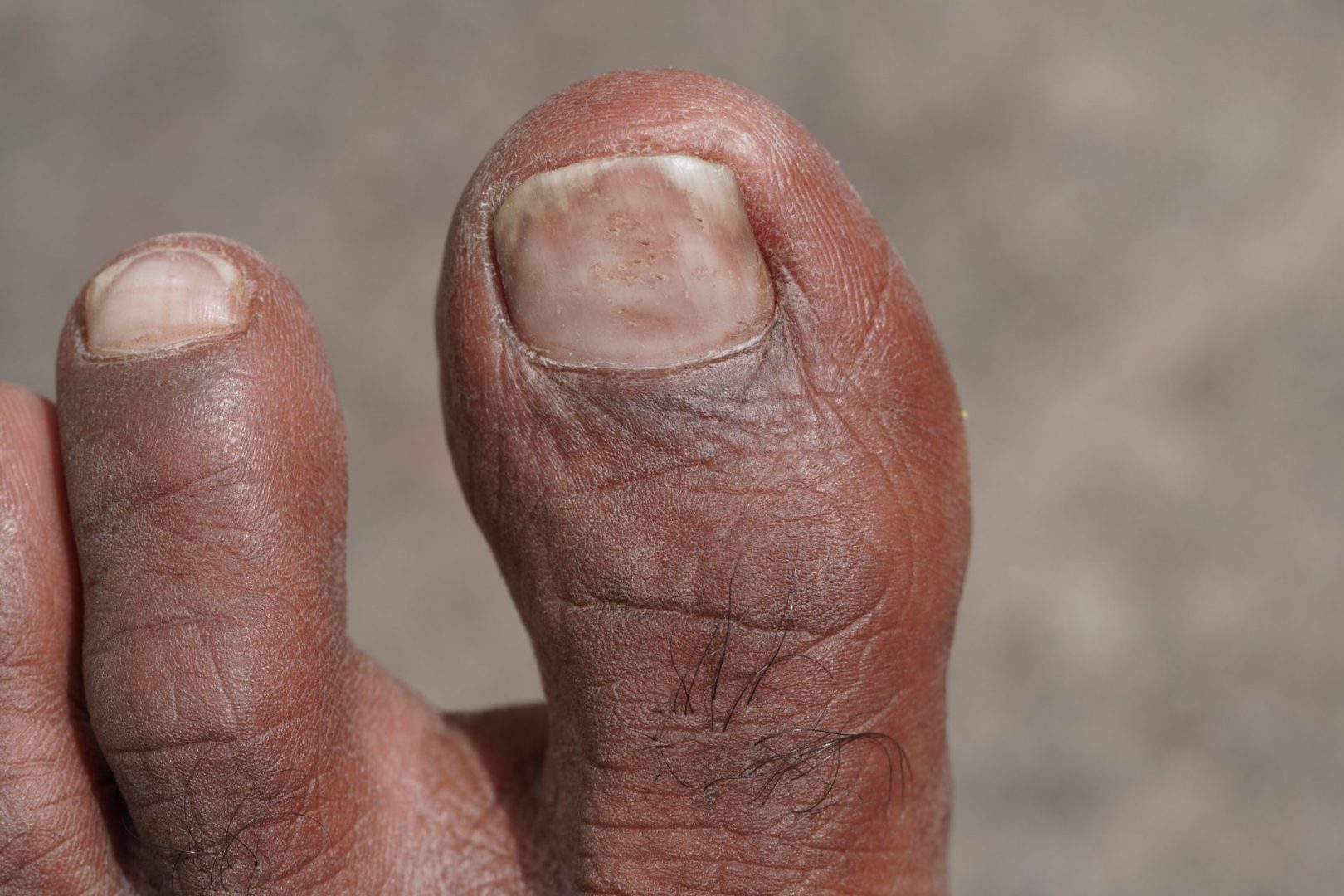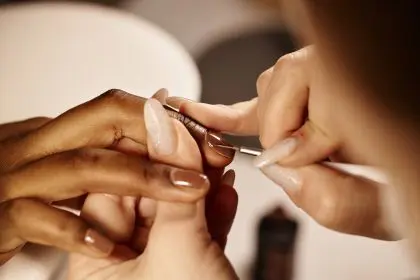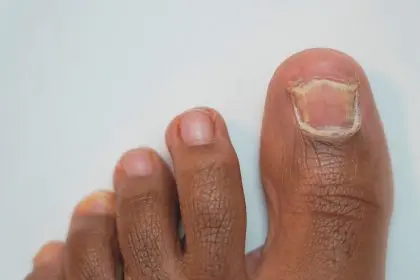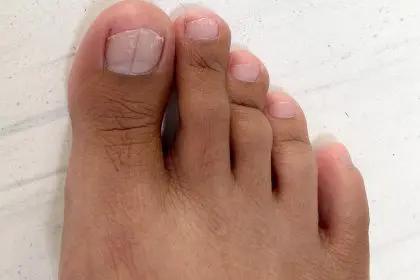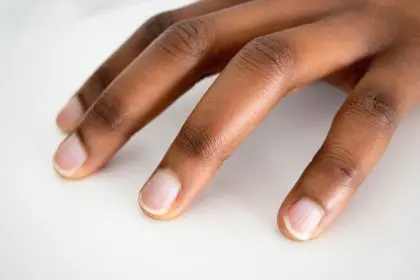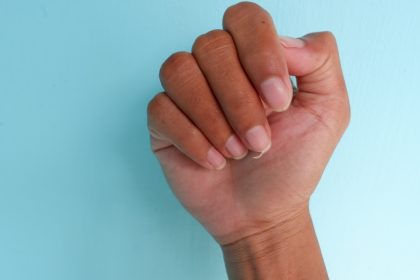These common nail conditions share similar symptoms but require completely different approaches
The confusing overlap in nail symptoms
Nail problems affect nearly 10% of adults, with fungal infections outnumbering psoriasis cases by almost three to one. This prevalence disparity leads many people to automatically assume any nail abnormality indicates fungus, potentially delaying proper treatment for those with psoriasis. Both conditions transform nail appearance through thickening, discoloration, and sometimes separation from the nail bed, making self-diagnosis particularly challenging without understanding the subtle distinctions between them.
The diagnostic confusion stems partly from how these conditions progress. Both develop gradually, often beginning with minor changes that worsen over months or years rather than appearing suddenly. This slow evolution makes tracking the precise onset and development pattern difficult for many people, removing valuable diagnostic clues that might otherwise help distinguish between the conditions. The confusion increases when someone has previously experienced one condition and automatically attributes new symptoms to the same cause.
The impact extends beyond mere aesthetics, as both conditions can cause physical discomfort and emotional distress. Thickened, misshapen nails catch on clothing, making daily activities like typing, cooking, or handling small objects difficult. The visible nature of fingernail involvement creates social anxiety for many sufferers, with some reporting withdrawal from activities where their hands might be noticed. This psychological burden often equals or exceeds the physical discomfort, making accurate diagnosis and treatment particularly important for quality of life.
The treatment approaches differ dramatically between these conditions, with remedies for one potentially worsening the other. Antifungal treatments offer no benefit for psoriatic nails and might further irritate sensitive skin around affected areas. Conversely, corticosteroids used for psoriasis could potentially worsen fungal infections by suppressing local immune responses. This treatment mismatch underscores the importance of distinguishing between these similar-appearing but fundamentally different nail conditions.
The distinctive visual clues of nail psoriasis
Pitting represents the most distinctive trademark of nail psoriasis, appearing as tiny dents or depressions across the nail surface. These small indentations resemble marks that might be made by pressing a toothpick into soft clay, typically appearing in patterns rather than isolated spots. The pits vary in size and depth but generally remain small enough that several could fit on a pencil eraser. This characteristic feature occurs because psoriasis affects the nail matrix – the tissue that produces the nail plate – leading to irregular cell production and these distinctive depressions.
Salmon-colored or “oil drop” discoloration provides another telltale sign of psoriasis. These translucent, yellowish-pink patches beneath the nail plate create an appearance reminiscent of oil droplets trapped under glass. The distinctive coloration results from inflammatory changes in the nail bed rather than from external staining or debris accumulation. Unlike fungal discoloration that typically begins at nail edges and spreads inward, these salmon patches often appear in the central nail area first and maintain relatively defined borders rather than gradual color transitions.
Red or brown linear streaks called splinter hemorrhages frequently appear in psoriatic nails. These thin, straight lines resemble splinters trapped under the nail but actually represent tiny areas of bleeding in the nail bed due to inflamed, fragile blood vessels. The streaks typically run in the direction of nail growth, from cuticle to tip. While other conditions including minor trauma can cause similar marks, their presence alongside other psoriatic signs increases the likelihood of psoriasis rather than fungal infection.
Nail thickening in psoriasis follows a distinctive pattern, often creating an uneven, wavy, or rippled surface. This irregular thickening results from involvement of both the nail matrix and the nail bed, causing variable growth rates across the nail width. The thickness changes may be more pronounced in certain areas, creating ridges or grooves running lengthwise on the nail. This pattern differs from the more uniform thickening typically seen in fungal infections, which tends to affect the entire nail plate more consistently.
The characteristic patterns of fungal nail infection
Uniform discoloration represents the hallmark of fungal nail infections, typically beginning with a white or yellow spot near the tip that gradually spreads toward the cuticle. This progression pattern – moving from the nail’s free edge inward – reflects how fungi typically enter through the space beneath the nail tip or through tiny fissures in the nail plate. As the infection advances, the discoloration often deepens to tan, brown, or even blackish hues, particularly when debris accumulates under the nail. This color change typically affects the entire nail plate rather than creating distinct patches or spots.
Nail thickening in fungal infections follows a predictable pattern, with the entire nail gradually increasing in thickness as the condition progresses. This uniform thickening occurs because the fungus disrupts normal nail formation while stimulating excessive keratin production. The thickened nail often takes on a curved or “ram’s horn” appearance, particularly in toenails where pressure from shoes accentuates this deformity. Unlike psoriatic thickening, which often appears irregular or wavy, fungal thickening typically affects the nail uniformly from side to side.
Subungual debris – the accumulation of crumbly, often gray or white material beneath the nail – strongly suggests fungal infection rather than psoriasis. This material consists of dead skin cells, nail fragments, and fungal elements that build up as the infection progresses. When the nail is trimmed or filed down, this debris often has a characteristic powdery or granular texture that can be readily distinguished from the more solid tissue buildup seen in psoriasis. The amount of debris typically correlates with infection severity and duration.
Odor development provides another distinguishing feature of fungal infections. The metabolic processes of the infecting organisms often produce compounds with distinctive unpleasant smells frequently described as musty, sour, or cheesy. This odor becomes more noticeable when shoes are removed or during nail trimming activities that disturb the accumulated debris. Psoriatic nails, by contrast, typically remain odorless even in advanced cases, as the condition involves inflammation rather than microbial growth.
The surrounding skin tells an important story
Skin involvement adjacent to affected nails offers critical diagnostic clues for distinguishing between these conditions. Nail psoriasis frequently appears alongside characteristic psoriatic skin lesions – raised, reddened patches covered with silvery-white scales – either nearby on the fingers or toes or elsewhere on the body. These patches may appear simultaneously with nail changes or develop before or after nail involvement. Their presence strongly suggests psoriasis rather than fungal infection as the underlying cause of nail abnormalities.
The cuticle and surrounding tissue display different changes in these conditions. Psoriasis often causes visible inflammation around the nail fold, with redness, swelling, and occasional scaling extending to the skin bordering the nail. This inflammation stems from the autoimmune nature of psoriasis, where the body attacks its own tissues. Fungal infections, conversely, typically cause less visible inflammation in surrounding tissues, though secondary bacterial infections can occasionally develop and create redness or swelling.
Skin thickening under the nail plate (subungual hyperkeratosis) occurs in both conditions but with different characteristics. In psoriasis, this thickening creates a firm, solid mass that remains attached to the underside of the nail. It results from accelerated skin cell production without normal shedding, creating a buildup of living tissue. Fungal infections produce a different type of accumulation consisting of detached, friable debris that easily crumbles when disturbed. This distinction becomes apparent during nail trimming or when examining the nail bed after the nail plate separates.
Multiple nail involvement patterns differ between these conditions. Psoriasis typically affects several nails simultaneously and often displays similar patterns across affected nails. This consistency stems from the systemic nature of psoriasis as an autoimmune condition. Fungal infections more commonly begin in one nail before gradually spreading to others, creating a progression pattern where some nails show advanced changes while others display early-stage infection or remain unaffected. This asymmetric presentation provides another useful diagnostic clue.
How lifestyle factors point toward specific diagnoses
Activity patterns and exposure histories provide important context for distinguishing between these conditions. Fungal infections correlate strongly with environments promoting fungal growth – warm, moist settings like public pools, communal showers, and fitness centers. Frequent sweating, particularly when wearing occlusive footwear for extended periods, creates ideal conditions for fungal proliferation. Individuals with these exposure patterns more likely have fungal infections, particularly when symptoms began after increases in such activities.
Health conditions and medication use create predispositions that differ between these nail problems. Psoriasis associations include other autoimmune conditions like psoriatic arthritis, rheumatoid arthritis, or inflammatory bowel disease. Fungal infection risk increases with diabetes, peripheral vascular disease, and immune suppression from medications or conditions like HIV. A thorough health history often reveals these telling associations, helping distinguish between similarly appearing nail changes based on the individual’s overall health profile.
Family history provides particularly strong evidence regarding psoriasis, which shows significant genetic predisposition. Individuals with first-degree relatives (parents, siblings, or children) affected by psoriasis face substantially higher risk of developing the condition themselves. This hereditary pattern does not appear with fungal infections, which spread through environmental exposure rather than genetic factors. A positive family history of psoriasis substantially increases the likelihood that nail abnormalities stem from psoriasis rather than fungal causes.
Previous treatment responses offer retrospective diagnostic clues. Failed responses to over-the-counter antifungal preparations suggest either resistant fungal strains or, more likely, misdiagnosed psoriasis. Similarly, improvement with exposure to sunlight or ultraviolet treatment points toward psoriasis rather than fungal infection, as ultraviolet light helps regulate immune function in psoriatic conditions but shows minimal effect on fungal growth. These historical response patterns often provide valuable diagnostic insights when current symptoms appear ambiguous.
The critical differences in treatment approaches
Topical treatments differ dramatically between these conditions in both formulation and application methods. Fungal infections typically respond to antifungal agents containing ingredients like terbinafine, ciclopirox, or undecylenic acid. These medications target the fungal cell membrane or disrupt other essential fungal processes. Psoriasis treatments, conversely, focus on controlling inflammation through corticosteroids, calcipotriene (a vitamin D analog), or tazarotene (a retinoid). Using the wrong category of topical treatment not only wastes time and resources but potentially worsens the original condition.
Oral medication approaches highlight the fundamental difference between these conditions. Fungal infections often require systemic antifungal medications like terbinafine or itraconazole to penetrate the nail plate effectively and eliminate deeply embedded fungal elements. These medications specifically target fungal cells while sparing human tissues. Psoriasis may require immune-modulating medications such as methotrexate, cyclosporine, or newer biologic therapies that regulate overactive immune responses causing the condition. These powerful systemic medications target entirely different pathological processes.
Professional procedures vary significantly depending on the diagnosis. For severe fungal infections, partial or complete nail removal might be recommended to eliminate all infected material and allow fresh nail growth. Laser treatments that selectively heat and destroy fungal elements while preserving surrounding tissue show promising results for fungal infections but offer minimal benefit for psoriasis. Conversely, targeted ultraviolet light therapy effectively treats psoriatic nails by reducing inflammation and normalizing skin cell production without affecting fungal growth.
Recovery expectations and timelines differ substantially between these conditions. Fungal infections, when properly treated, typically show gradual improvement as the infected portion of the nail grows out and gets replaced by healthy nail. Complete resolution often requires 6-12 months as the nail slowly regenerates. Psoriatic nail improvements typically occur more quickly with appropriate treatment, sometimes showing noticeable changes within weeks, though complete resolution may take months. Understanding these different timelines helps patients maintain treatment adherence and realistic expectations.
Prevention strategies for recurrence protection
Environmental modifications play different roles in preventing recurrence of these conditions. For fungal infections, environmental control proves critical, with strategies focusing on keeping feet dry, wearing breathable shoes and moisture-wicking socks, using antifungal powders in shoes, and avoiding barefoot walking in public wet areas. These measures reduce exposure to fungal elements and create less hospitable conditions for their growth. For psoriasis, environmental strategies focus more on avoiding triggers like stress and preventing nail trauma that could initiate a new cycle of psoriatic changes.
Maintenance therapy follows different protocols based on the underlying condition. Fungal infection prevention often involves periodic use of topical antifungal treatments even after apparent cure, particularly in high-risk situations like athletic activities or during humid weather. This prophylactic approach helps prevent reinfection by addressing fungal elements before they establish a clinical infection. Psoriasis maintenance typically involves continued immune regulation through appropriate medications and lifestyle measures rather than intermittent treatment, reflecting the chronic nature of this condition.
Dietary considerations affect these conditions differently. Fungal control receives minimal benefit from dietary changes, though general nutrition supporting immune function may provide modest advantages. Psoriasis management, conversely, shows stronger connections to dietary factors, with some individuals reporting improvement when following anti-inflammatory eating patterns like the Mediterranean diet or when eliminating specific trigger foods. This difference reflects psoriasis’s nature as an inflammatory condition influenced by systemic factors versus the primarily local, infectious nature of nail fungus.
Stress management impacts these conditions through different mechanisms. Psoriasis shows well-documented stress reactivity, with flares commonly occurring during or after periods of significant psychological stress. This connection stems from stress hormones’ influence on immune function, directly affecting the inflammatory processes driving psoriatic changes. Fungal infections show less direct stress correlation, though severe or chronic stress may slightly increase susceptibility through general immune suppression. This distinction provides another clue for distinguishing between similarly appearing nail conditions.
The path to healthy nails begins with accurate identification of the underlying condition causing nail changes. While nail fungus and nail psoriasis share superficial similarities, their fundamental differences in appearance, associated factors, and treatment requirements make proper diagnosis essential for effective management. By understanding the distinguishing features outlined above, individuals experiencing nail changes can seek appropriate care and avoid the frustration of ineffective treatments based on misdiagnosis. With proper identification and targeted treatment, both conditions can be effectively managed, allowing restoration of nail health and elimination of the physical and emotional burdens these conditions often create.

